|
|
| Line 7: |
Line 7: |
| | For the generation of the magnetic field, loop antennas are used, with the exact specifications of wire thickness and number of windings, as specified in the used standard. Several [[:Category:Equipment_Manufacturer|manufacturers]] are providing loop antennas based on these specifications. | | For the generation of the magnetic field, loop antennas are used, with the exact specifications of wire thickness and number of windings, as specified in the used standard. Several [[:Category:Equipment_Manufacturer|manufacturers]] are providing loop antennas based on these specifications. |
| | | | |
| − | The current flowing through the loop antenna is a one on one relation to the generated magnetic field. For the measurement of the current different measurement methods are available that can be used in combination with {{RadiMation}}. It can be measured using a shunt resistor, or a current sensor. To characterize and validate the generated magnetic field, first a calibration is needed which is using another magnetic field monitoring loop connected to a frequency selective powermeter to verify the result. The result of that calibration can then also be used during the actual substitution test. | + | The current flowing through the loop antenna is a one on one relation to the generated magnetic field. For the measurement of the current, different measurement methods are available that can be used in combination with {{RadiMation}}. It can be measured using a shunt resistor, or a current sensor. To characterize and validate the generated magnetic field, first a calibration is needed which is using another magnetic field monitoring loop connected to a frequency selective powermeter to verify the generated magnetic field. The result of that calibration can then also be used during the actual substitution test. |
| | | | |
| | == Necessary equipment == | | == Necessary equipment == |

|
| Warning:
|
This application note is stil work in progress! It still contains unrelated and incomplete information!
|
|
How to perform magnetic field close proximity tests
This RadiMation® application note explains how the close proximity radiated immunity magnetic field tests can be performed with RadiMation®. These tests are described in several standards, including the IEC 61000-4-39:2017 and the MIL-STD-461 RS101.
Magnetic field tests
For the generation of the magnetic field, loop antennas are used, with the exact specifications of wire thickness and number of windings, as specified in the used standard. Several manufacturers are providing loop antennas based on these specifications.
The current flowing through the loop antenna is a one on one relation to the generated magnetic field. For the measurement of the current, different measurement methods are available that can be used in combination with RadiMation®. It can be measured using a shunt resistor, or a current sensor. To characterize and validate the generated magnetic field, first a calibration is needed which is using another magnetic field monitoring loop connected to a frequency selective powermeter to verify the generated magnetic field. The result of that calibration can then also be used during the actual substitution test.
Necessary equipment
The following test and measurement devices are needed:
- Signal generator
- Amplifier
- Transmitting loop antenna (accoording the specifications of the used standard)
- Cables
The current flowing through the loop antenna can be measured by one of the following methods, and depending on the used method, the following additional test and measurement devices are also needed:
- Current sensor and powermeter
- Resistor and multimeter
- Resistor and oscilloscope
For the calibration of the magnetic field two additional test and measurement devices are also needed:
- Receiving loop antenna (accoording the specifications of the used standard)
- Measurement receiver
Calibration
During the calibration the magnetic field transmitting loop and magnetic field monitoring loop are positioned close to each other, with a specified distance. The current through the magnetic field transmitting loop is then increased until the desired magnetic field level. The magnetic field monitoring loop connected to the spectrum analyser is used to measure the actually generated magnetic field.
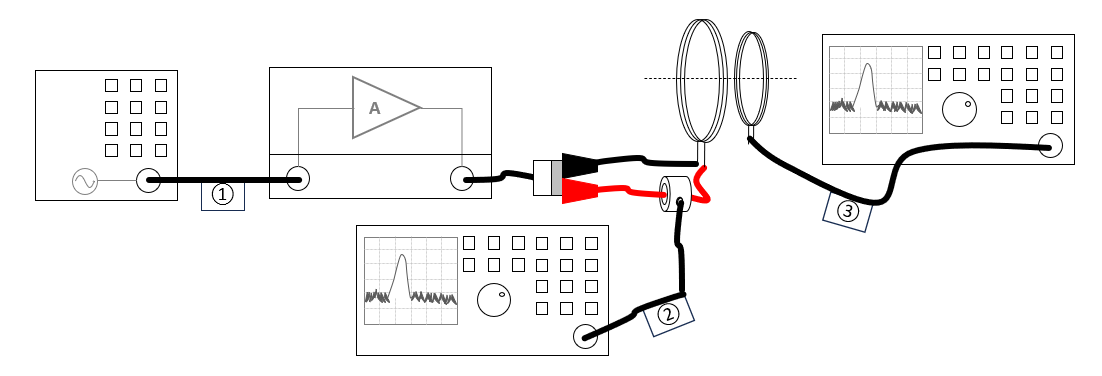
Instead of using a current sensor and powermeter, it is also possible to use a shunt resistor and a multimeter, or use the oscilloscope instead of the multimeter
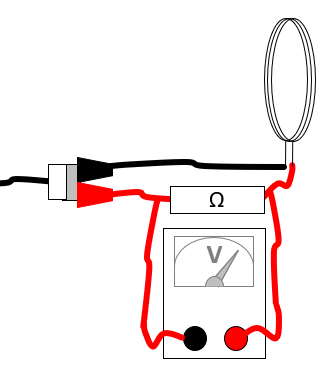
The Magnetic field calibration can be started in RadiMation® by selecting from the menu:
-
 Calibration
Calibration
-
 System Calibration
System Calibration
-
 Radiated Immunity
Radiated Immunity
-
 Mil Std Calibration
Mil Std Calibration
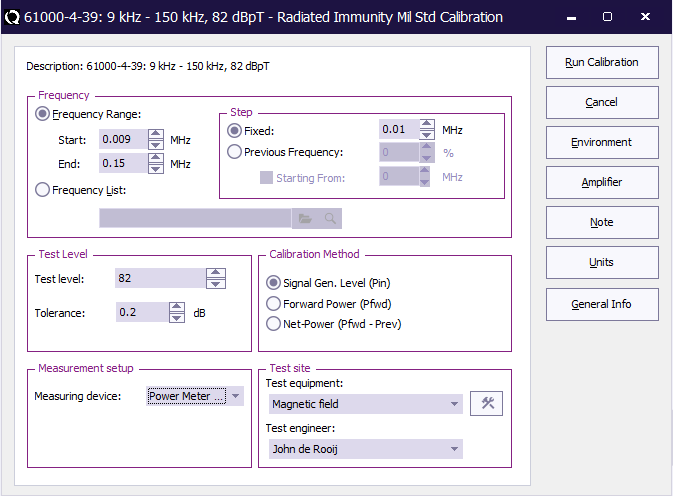
In the Mil Std Calibration dialog, the required settings can be configured. The used standard often specifies most of these settings.
 Start Start
|
The start frequency of the calibration. For example 9 kHz.
|
 End End
|
The end frequency of the calibration. For example 150 kHz.
|
 Step Fixed Step Fixed
|
The frequency step that should be used to increment the frequency. For example 10 kHz.
|
 Step Logarithmic Step Logarithmic
|
The percentage of the frequency that should used to increment the frequency. For example 1 %.
|
 Test level Test level
|
The desired magnetic field testlevel that should be calibrated. For example 82 dBpT.
|
 Tolerance Tolerance
|
The tolerance (specified in dB) that should be used for the accuracy of the regulated testlevel. For example: 0.2 dB.
|
 Coupling device Coupling device
|
Which device is used for the measurement of the current. This can be Current Sensor or Resistor.
|
 Measurement device Measurement device
|
The device that is used for the measurement of the selected coupling device. This can be Multimeter, Powermeter or Oscilloscope.
|
 Test equipment Test equipment
|
The name of the testsite that should be used. This testsite should at least have all the required equipment.
|
 Test engineer Test engineer
|
The name of the engineer who is performing the calibration.
|
The Coupling Device and the Measuring Device allow to select the measurement equipment that are used to measure the current through the magnetic field generation loop.
If the Power Meter is selected for the Measuring device, the actually used powermeter should be selected in the testsite as the Sensor powermeter.
The magnetic field generation loop antenna should be selected in the testsite as the Antenna.
The magnetic field monitoring antenna should be selected in the testsite as the Calibration antenna. This antenna device driver should have a Magnetic Field Factor (dBpT/uV) correction file selected as the third correction file in the device driver settings of the antenna device driver. ( also see Magnetic Field Factor correction in Chapter 14 of the manual)
The measurement receiver connected to the field monitoring antenna should be selected in the testsite as the Spectrum Analyzer.
When this calibration is started, the signal generator will generate every frequency, and the power level is regulated to the desired magnetic field level as it is measured by the Spectrum Analyzer and the Calibration antenna. At the end of the system calibration a 'Save Calibration As' dialog is shown, which allows to save the result of the calibration to a .CAL calibration file.
It is advised to specify a useful location and filename for this magnetic field calibration file.
EUT measurement
Once the system calibration has been performed, the EUT can be installed and prepared. Also open an EUT file in RadiMation® to store the measurement results of the tests.
The equipment configuration that is needed for the actual test is very similar to the calibration setup.
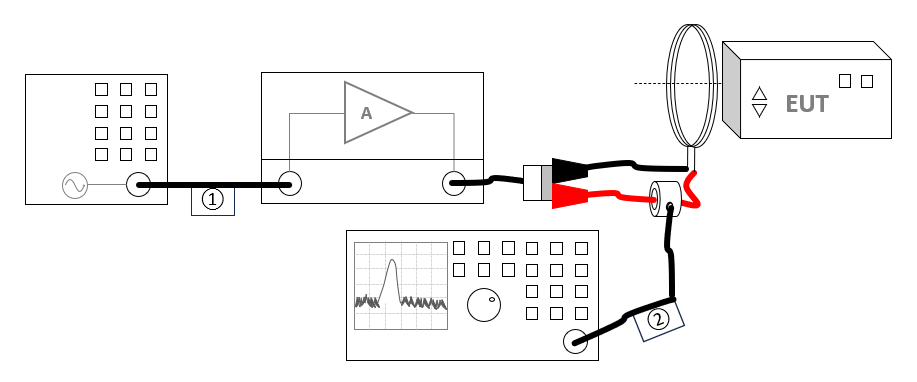
To perform the real magnetic field close proximity test, the earlier created calibration file can be used to generate the requested magnetic field.
Just use a Radiated Immunity Multiband test by selecting from the menu:
-
 Tests
Tests
-
 Radiated Immunity
Radiated Immunity
-
 Multiband
Multiband
All the desired test parameters can be set in this configuration window:
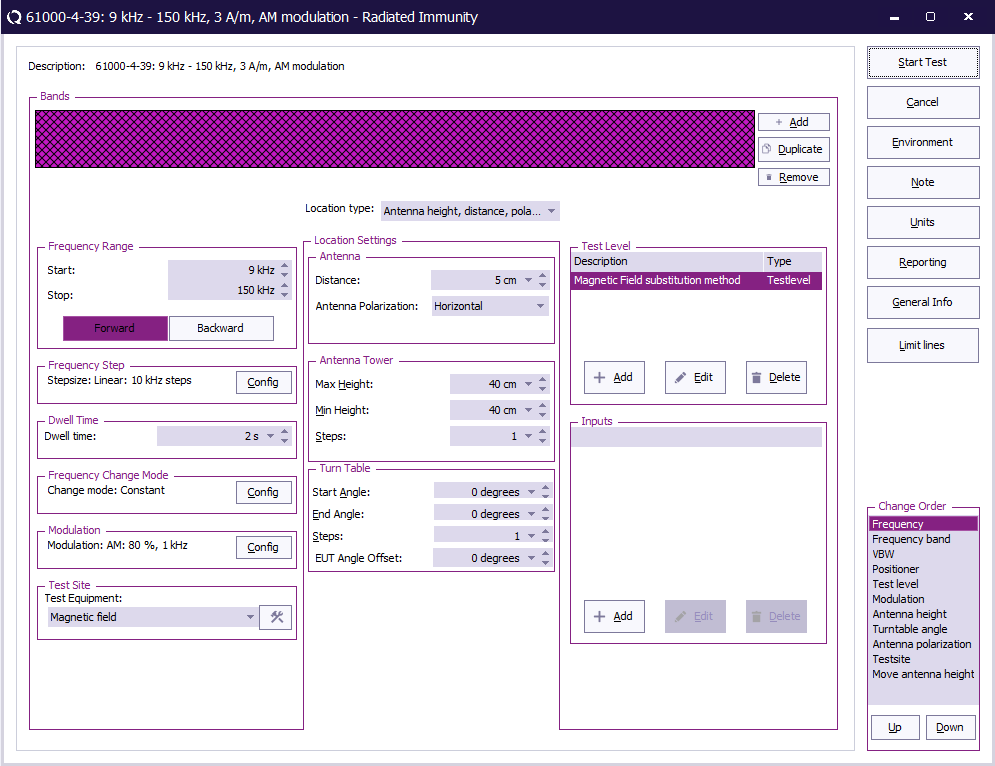
 Start Start
|
The start frequency of the test. For example 9 kHz.
|
 Stop Stop
|
The stop frequency of the test. For example 150 kHz.
|
 Frequency step Frequency step
|
The frequency step that should be used to increment the frequency. For example 10 kHz.
|
 Dwell time Dwell time
|
The dwell time that should be used at every frequency. For example 2 seconds.
|
 Frequency change mode Frequency change mode
|
The mode that should be used to change from one frequency to the next frequency.
|
 Modulation Modulation
|
The modulation that should be applied during the dwell time at each frequency.
|
 Test equipment Test equipment
|
The name of the testsite that should be used. This testsite should at least have all the required equipment.
|
 Location type Location type
|
The type of test that should be used. For a magnetic field test use Antenna height, distance, polarization and angle.
|
 Antenna distance Antenna distance
|
The used distance between the antenna and the EUT. For example 10 cm.
|
 Antenna polarization Antenna polarization
|
The polarization of the antenna related to the EUT. For a loop antenna, just specify Horizontal.
|
 Antenna tower Antenna tower
|
The minimum, maximum and number of heights that should be moved with an automated antenna tower.
|
 Turn table Turn table
|
The start and end angle and how many angles should be measured with an automated turntable.
|
 Test level Test level
|
The configuration of the testlevels and limits that should be used during the regulation of the test.
|
 Inputs Inputs
|
The configuration of additional inputs that should be measured during the test.
|
In the test configuration a Magnetic Field substitution method testlevel can be added. In the Magnetic Field substitution method testlevel configuration the .CAL file can be selected again, and the requested testlevel can be specified. In this configuration dialog, also the levelling method can be selected, which also has the option to regulate on the current flowing through the magnetic field generation loop.
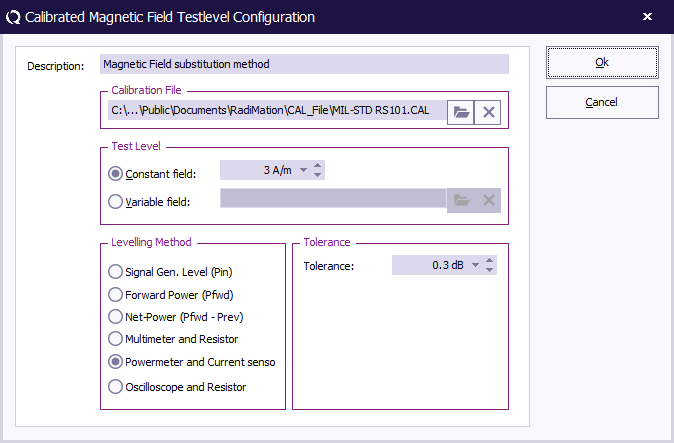
 Description Description
|
Specifies the name that should be used for this testlevel.
|
 Calibration file Calibration file
|
The calibration file which is the result of the system calibration, and which is now used to regulate to the desired testlevel.
|
 Testlevel constant field Testlevel constant field
|
The desired testlevel for the magnetic field.
|
 Testlevel variable field Testlevel variable field
|
A correction file that should be used to for a frequency depending testlevel, which allows to do variation of the magnetic field strength over the frequency.
|
 Levelling method Levelling method
|
Which device combination should be used to regulate the power and/or current, and thus also the magnetic field.
|
 Tolerance Tolerance
|
The tolerance (specified in dB) that should be used for the accuracy of the regulated testlevel. For example: 0.3 dB.
|
The requested test level doesn't need to be the same as the calibrated magnetic field, as RadiMation® will automatically calculate the corresponding current if another testlevel is specified.
When this test is started, the signal generator will be set to every frequency again, the current flowing through the transmitting loop antenna will be regulated to the current that is determined during the calibration, which correlates to the requested magnetic field.
Once the EUT test is finished, the results of this test is stored in the EUT file, and available as one of the performed Tests in the EUT file. Selecting the corresponding test result and pressing on Info will show the test results again.
The magnetic field transmitting loop should be located close to the EUT itself. If the EUT is larger than the illumination area of the transmitting loop, the same test has to be repeated for example for every 50cm x 50cm area of the EUT, on all sides of the EUT. This can be easily done by repositioning the loop antenna, and starting the same test in RadiMation® again.
Closed loop regulation
Optionally also a Magnetic Flux Density correction file can be selected as the second correction file in the device driver settings of the magnetic field generating loop antenna. The correction file should include a frequency column and a correction column, where the values in the correction column are expressed in 'pT/A'. (also see: Magnetic Flux Density correction file in Chapter 14 of the manual). In the MIL-STD-461, this correction value is specified as 9.5x10^7 pT/A. This Magnetic Flux Density value is used to determine the calculated magnetic field based on the measurement of the current flowing through the magnetic field generation loop antenna.
Conclusion
The RadiMation® Radiated Immunity Mil Std calibration can be used to characterize the generated magnetic field by measuring the current through the transmitting loop, and storing it in a calibration file.
The Multiband Radiated Immunity test can then use the calibration file to re-apply the required current (and thus the desired magnetic field) again. This test can then be used to test if the EUT is not influenced by the generated magnetic field.





